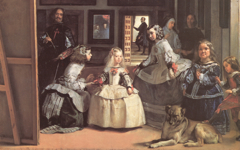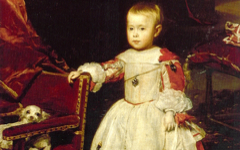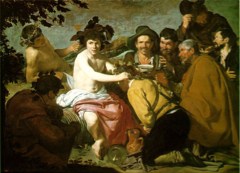Velazquez’s Infanta Margarita (1653)

Studio of Velazquez, Portrait of the Infanta Margarita (1653) Oil on canvas. 70 x 58 cm. Louvre, Paris.
Click image to enlarge.
Velazquez's 1653 Portrait of the Infanta Margarita, the girl who was later to star in Las Meninas, is a small painting no longer thought to be entirely by the master's hand but not everyone agrees.1 It is nevertheless quite clearly a composition by Velazquez regardless of who put the paint on. It's a modest picture for the Louvre - not even displayed nowadays - but it has captured the attention of some of the world's great artists. Finding the reason for that is the interpreter's principal task.
Click next thumbnail to continue

Top L: Manet, Infanta Margarita (1861-3) Etching.
Top R: Degas, Infanta Margarita (1861-2) Etching and drypoint.
Bottom L: Matisse, Portrait of Marguerite (1906-7) Musée Picasso, Paris.
Bottom R: Manet, Boy with a Sword, detail (1861) Metropolitan Museum, New York.
Click image to enlarge.
A French vogue for Spanish culture flourished in Paris for most of the 19th century. Yet despite the public exhibition of many Spanish masterpieces this small canvas captured the attention of Millet, Manet, Degas, Matisse and Picasso. Both Manet and Degas did etchings after it when young (top); Matisse based a portrait of his namesake-daughter on it (lower L). Picasso, aware of the source, then chose this "simple" picture for his own collection leaving experts to wonder why. Manet's portraits of his blond son, Léon Leenhof (lower R), were probably also inspired by the Infanta like depictions of his equally blond model, Victorine Meurend, the star of Olympia and Le Déjeuner sur l'Herbe.
Click next thumbnail to continue
What did these masters recognize in the Infanta? The half-seen chair would perhaps recall how an artist sits to the side of his canvas while looking around its edge to check the model. The Infanta's hand on its seat resembles Titian's in his self-portrait (bottom) lightly touching a bare table, a motif acknowledged by Titian experts to reference painting on a blank canvas.2 Touching gestures, though rarely recognized, often do so.3 Velazquez may have been inspired by Titian's self-portrait which he would have seen in Venice between 1629 and 1631. Note how both figures wear gold chains, the traditional symbol in art for an artist's honor and both backgrounds are similarly bare and brown.4 To Velazquez, the princess, then-heir to the Spanish throne, would have represented the purity and "royalty" of his mind and its androgyny too, as I have argued she does in Las Meninas. The self-reference is further strengthened by the design on her bodice, a large V in black for Velazquez.5
Click next thumbnail to continue
The princess in Velazquez's mind is like Beatrice in Dante's or Christ in Michelangelo's, a reflection of all that is pure in themselves. That is why her hair is shaped like the bristles of a paintbrush with a line (a few strands of hair) descending down the side of her forehead like a thin brushstroke. The handle of the brush, of course, must be imagined.6 Matisse was clearly aware of this because he also shaped his daughter Marguerite's hair into something else, as explained in its own entry.7 The other French artists drawn to this portrait must have seen the hidden paintbrush too because each of them in their own work made use of similar methods.
Click next thumbnail to continue
This portrait of the Infanta may not in the end be entirely by Velazquez's own hand. So what? It is still his composition, probably based on a drawing or lost original, and it would not have left his studio without his approval. In reproduction, as seen by most people today, the issue is inconsequential; meaning matters more. Seen then through the eyes of major artists, its place in the development of art becomes much more significant. The Louvre should put the picture back on display if only because so many great masters from Paris' past would want it there. And for good reason.
More Works by Velazquez
Notes:
1. Genevieve Lacambre, "The Discovery of the Spanish School in France" in Manet/Velazquez: The French Taste for Spanish Painting (New York: Metropolitan Museum of Art) 2011, p. 72
2. Jodi Cranston, The Poetics of Portraiture in the Italian Renaissance (Cambridge: Cambridge University Press) 2000, p. 119; Cranston, “Theorising Materiality: Titian’s Flaying of Marsyas” in Titian: Materiality, Likeness, Istoria (Turnhout, Belgium: Brepols) 2007, p.13
3. See the theme Pointing and Touch
4. Jonathan Brown has long argued that Velazquez's social ambition and desire for ennoblement were the principal driving factors behind Las Meninas. To my eye he is far from the truth on the poetic level but probably correct in terms of how Velazquez intended his general audience to perceive the painting. It thus makes sense that the gold chain worn by the princess is a self-reference to art and the artist's high status. It is worth noting that Titian's arms and the Infanta's each describe a long arc over the shoulders. See also the theme State Honors.
5. Velazquez, in my opinion, might well have helped choose the dress. He was held in high regard by the king and had painted many portraits of the royal family in full regalia. He had also once been an assistant in the king's wardrobe and would have developed considerable knowledge of royal costumes. Also note that the the chair-back resembles a gold-framed painting. See also the theme Letters in Art
6. See the theme Brush and Palette
Original Publication Date on EPPH: 10 Feb 2015. © Simon Abrahams. Articles on this site are the copyright of Simon Abrahams. To use copyrighted material in print or other media for purposes beyond 'fair use', you must obtain permission from the copyright owner. Websites may link to this page without permission (please do) but may not reproduce the material on their own site without crediting Simon Abrahams and EPPH.





